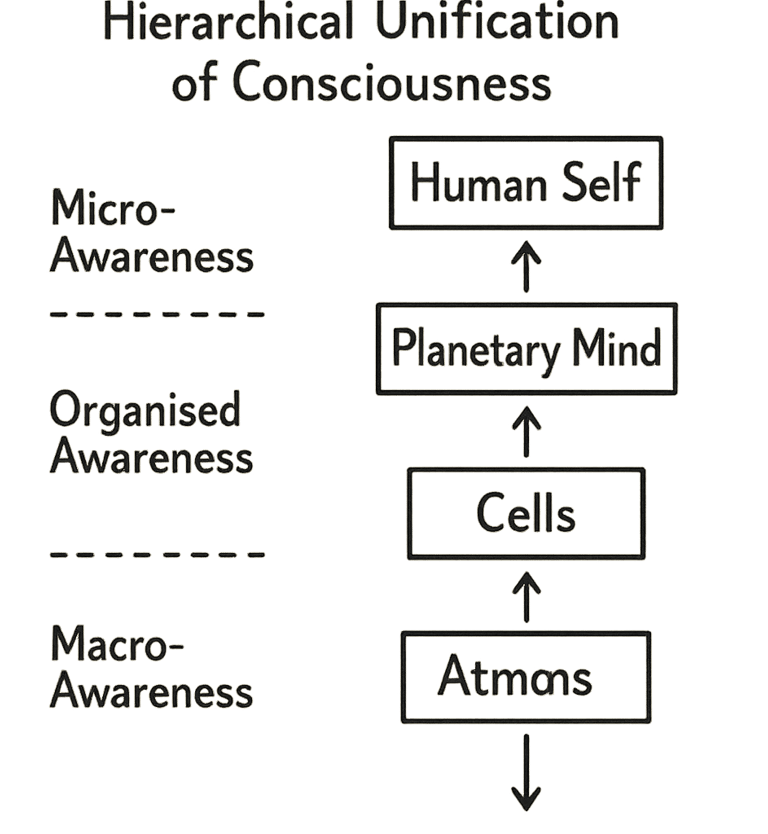The Combination Problem in Panpsychism — and How Similarity Theory Resolves It
1. Introductiona
In panpsychism, consciousness is considered a fundamental feature of reality. Every atom, particle, and physical system possesses some degree of awareness — a "micro-consciousness". This approach elegantly avoids the "hard problem of consciousness" — the puzzle of how subjective experience arises from purely physical matter (1).
However, panpsychism faces a formidable challenge: the combination problem (2). If each atom has its own private awareness, how do these countless micro-consciousnesses merge into the single conscious self that we each experience? A person is composed of trillions of atoms, yet experiences reality as a unified “I,” not as trillions of disconnected observers.
This question has been called the Achilles’ heel of panpsychism (3). Traditional formulations often struggle to explain how many small experiences fuse into a single coherent field of awareness.
2. The Combination Problem Explained
2.1 Definition
The combination problem asks: How can distinct conscious entities fuse into a larger conscious entity without losing their own awareness or existing as mere mechanical components?
2.2 The Micro-to-Macro Gap
Imagine each atom in your brain as a person in a stadium, each tuned to a different radio station. Without a unifying system, the result would be noise — no coherent song, no shared perception.
2.3 Why It’s Difficult for Standard Panpsychism
Standard panpsychism treats each micro-consciousness as self-contained, without a built-in mechanism for binding. While some propose “integration” or “entanglement” as solutions, these often rely on speculative physics without addressing the structural gap (4).
3. How Similarity Theory Resolves the Problem
Similarity Theory offers two key principles that overcome the combination problem:
3.1 Consciousness as an Organising Force
In Similarity Theory, consciousness is not merely in things — it is a structural force operating across dimensions and time, organising matter and energy into coherent patterns. Micro-consciousnesses are not isolated sparks; they are linked in a patterned field. As gravity shapes planetary orbits, consciousness shapes micro-awareness into unified wholes.
3.2 Hierarchical Self-Similarity
The framework rests on self-similarity across scales (as above, so below). The unification of consciousness mirrors the unification of physical structures:
Micro scale: quantum events cohere into atomic states.
Human scale: trillions of micro-conscious units resonate into a unified subjective field — “Self.”
Cosmic scale: planetary minds emerge from the resonance of billions of organisms, eventually combining into a universal mind.
Because the pattern repeats at all scales, binding is not an exception — it is structurally inevitable.
4. Atom-to-Human Unification
4.1 Step-by-Step Example
Atomic Consciousness: Awareness of quantum state and relations.
Molecular Resonance: Atoms bond chemically, aligning micro-consciousness into a “molecular mind.”
Cellular Integration: Molecules form cells; collective awareness becomes a cell-level self.
Neural Networks: Cells form brain networks, producing a brain-level self.
Human Self: Billions of neurons resonate into a single unified field — the person you call “I.”
4.2 Analogy
This is like an orchestra:
Each musician (atom) has their own instrument (awareness).
The shared score (structural pattern) harmonises them.
The conductor (organising force) synchronises them into one performance.
5. Higher-Scale Unification
5.1 Planetary Consciousness
Just as atoms form a human being, billions of conscious beings may form a planetary mind. The internet, ecosystems, and cultural exchange act as its neural pathways.
5.2 Cosmic Consciousness
At the highest scale, the universe itself becomes a unified conscious entity, formed by the resonance of planetary minds across dimensions. This resolves the “top-level” combination problem: even universal awareness binds through the same self-similar organising principle.
6. Why This Works
The strength of Similarity Theory is that the same unifying mechanism applies at all levels:
Micro to macro, atom to human, human to planet, planet to cosmos.
The “self” emerges from patterned resonance in consciousness, just as structure emerges from resonance in matter.
7. Diagram: Hierarchical Unification of Consciousness
[Atoms] → [Molecules] → [Cells] → [Human Self] → [Planetary Mind] → [Cosmic Mind] Micro-Awareness Organised Awareness Macro-Awareness
References
Goff, P. (2019). Galileo’s Error: Foundations for a New Science of Consciousness. Vintage.
Chalmers, D. J. (2017). The Combination Problem for Panpsychism. In Panpsychism (eds. Goff, Seager, & Allen-Hermanson). Oxford University Press.
Seager, W. (2020). Theories of Consciousness: An Introduction and Assessment. Routledge.
Strawson, G. (2006). Realistic Monism: Why Physicalism Entails Panpsychism. Journal of Consciousness Studies, 13(10-11), 3–31.



